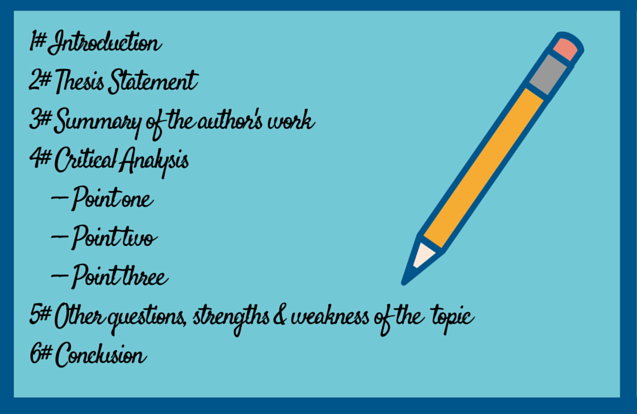
When you get a task to prepare a critical analysis essay for tomorrow, what is your first thought? We guess it is something like, “I won’t manage it!” If it is so, there is no reason for stress or fear. We can offer you a perfect solution.
First of all, you should know what you are expected to write. We know how to write a critical analysis, and we will help you get an insight into all the details. This kind of academic papers shows the student’s ability to make thorough analysis of a book or movie. It is one of the most common tasks in high school and college. Do not muddle together such different assignments as a report which is also related to articles, books, films, paintings, and other pieces of art.
What does perfect critical analysis give to the readers? They get excellent assessment of the analyzed piece with reflection over its good and bad aspects. You have to learn how to write a critical review right away not to make any mistakes. Follow the guidelines given by experts in academic writing and earn the best reputation at your educational establishment.
A critical analysis definition presents it as a type of academic papers written for understanding written works. It demonstrates the ability of rational thinking and using logics in terms of certain beliefs and actions. This kind of writing is far from objectivity as it contains your personal opinions and points of view. What you have to do is to share your evaluations and experience for the others to learn from it.
So, learn how to do critical reading and then start writing. What is a critical analysis? It is your subjective evaluation of a certain text or other piece of art. Learn how to do I effectively with the help of our professional tips.
Critical Analysis Essay Outline
Having studied general ideas about the critical analysis, you can proceed to writing a critical analysis essay outline. A typical outline looks like that:
I. Background details on the general nature of the analyzed work
Details about the analyzed work
- Title
- Name of the author
- Details about publication
- Statement of the main topic and aim
Thesis statement with the mentioned reaction of the author
II. Summary of the work
III. Evaluation
- Analysis of the organization
- Evaluation of the style
- Efficiency
- Discussion of how the topic is treated
- Evaluation of the efficiency of the appeal to a chosen audience
If you want to know how to start off an essay properly, you have to begin with careful reading. Identify the purpose of the author and analyze the text. Note the key ideas of the text and analyze how the main ode is supported. You can use both primary reference materials, like books, and secondary reference materials, like interviews to get thorough understanding of the text. Work on a summary and description of the work, taking into consideration the purpose of the work. Is it written to entertain, reveal a position, or simply to inform?
Learn how to write a critical analysis essay step by step and do proper evaluation of how well the author meets the set goal.
Rule 1 to follow: read and then write!
Evaluation can be effective only if you have read a poem, novel, story, or whatever you have to work on. Get a notebook, a pencil, and some stickers. Focus on the essay topic and analyze the main parts of the book, taking notes. Note the concepts and terms you do not understand. Follow the critical analysis essay format and meet the requirements given by the teacher to get high grades.
Rule 2 to follow: create a great title!
A good title has to help you concentrate on the main ideas. Get a clear vision, and that will help your readers get through your writing easily.
Criticize the work following the MLA format, APA format, or any other required by your teacher. Make your essay well-reasoned, structured, and clear. Do not be negative in your judgment. You can either disagree or agree with the author, but use strong arguments to support your idea.
A typical critical analysis essay template always follows the following structure: Introduction – Body – Conclusion.
Introduction. Note that a critical analysis essay introduction serves as a preview with a sentence at the beginning that draws the attention of the readers to the essay. It contains an outline of the key ideas, thesis of the author, and your thesis to start the discussion.
Body. This part develops a discussion in several paragraphs. They address the questions presented in the introductory part and provide examples, quotes, and evidence for the required support of the opinions. The sections of the essay body follow the same structure: TOPIC sentence – SUPPORTING evidence – CONCLUDING part.
Conclusion. A critical analysis essay conclusion restates the main opinion, matching the introduction and creates a final argument based on the provided explanations.
Critical Analysis of Literature: Things to Remember
- Critical analysis of literature does not look professional if it contains such phrases as “in my opinion” or “I think”. The focus should be on the analysis, not your personality.
- Start with the introduction of the analyzed work. It is wrong to assume that every reader knows a lot of details about the work.
- Consider some aspects: controversies, structure, subjects, etc.
- Mention the subject matter and evaluate of it is of current interest.
- Think about the value of each passage you use in text.
- Include the analysis of both strengths and weaknesses in your evaluation essay.
- Add details and evidence with documented paraphrases and quotes.
- The aim of a commentary essay should be informing with evaluation given to the excellence, beauty, truth, worth, and merits of the work.
- A critical analysis paper demands fair attitude of an open-minded author. It is ok to reveal the points of view, but they are expected to be well grounded and supported with evidence.
- An excellent review should inform, evaluate, and interpret. Help the readers get an insight into the analyzed work, explain meanings, and present discuss your opinions with proper justification.

